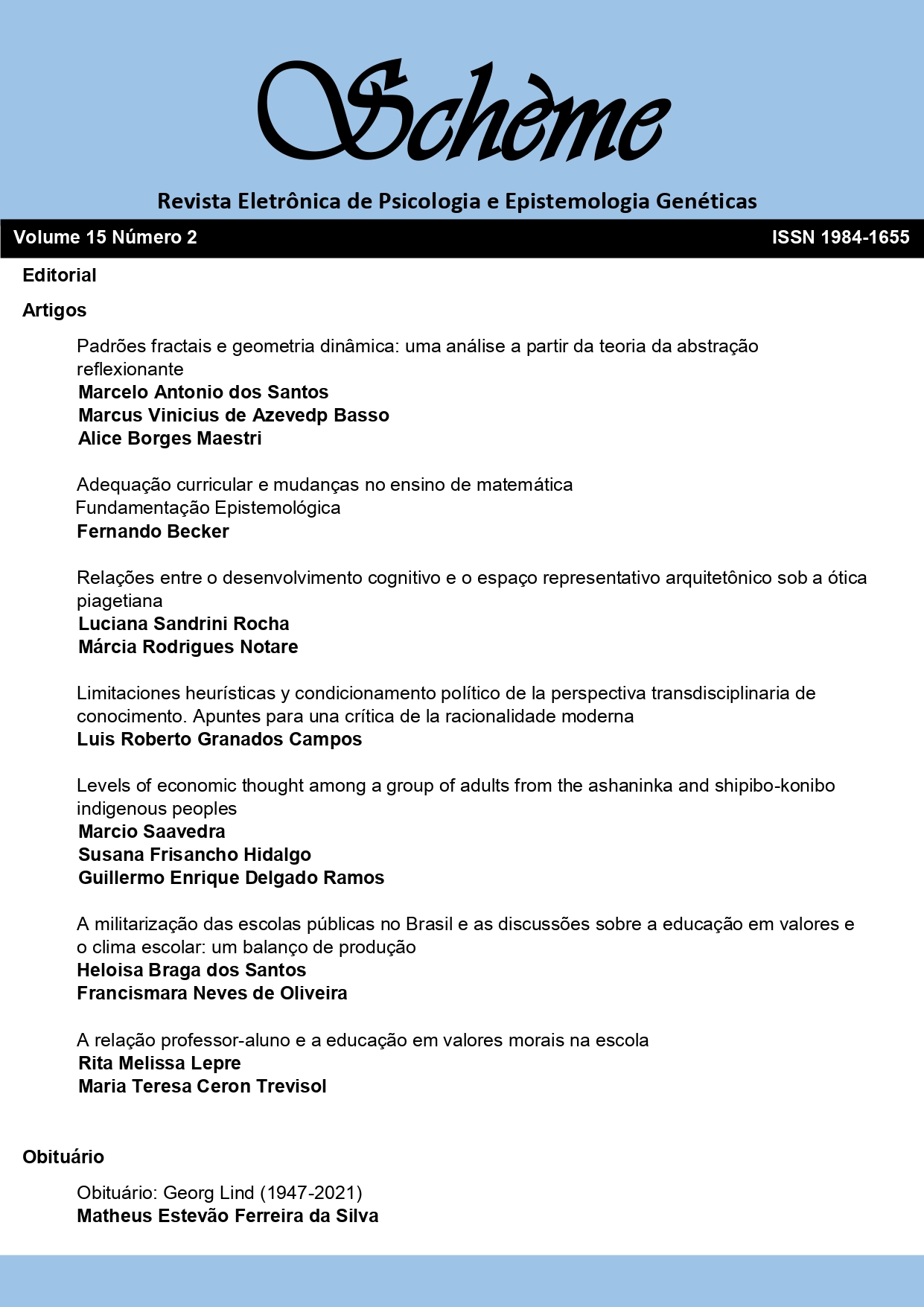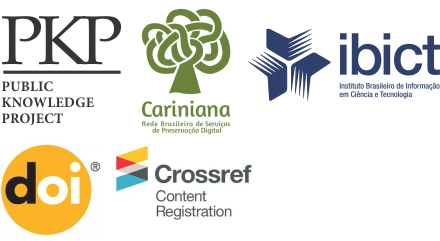RELAÇÕES ENTRE O DESENVOLVIMENTO COGNITIVO E O ESPAÇO REPRESENTATIVO ARQUITETÔNICO SOB A ÓTICA PIAGETIANA
DOI:
https://doi.org/10.36311/1984-1655.2023.v15.n2.p92-131Keywords:
Raciocínio espacial, Espaço representativo, Abstrações reflexionantes, Piaget, BIMAbstract
Training in Architecture, Engineering and Construction (AEC) requires professionals to be able to plan, represent and interpret information represented graphically and textually in architectural projects and, therefore, their ability to reason spatially. However, students have had difficulties with this type of reasoning and, allied to this, the development of the BIM (Building Information Modeling) system and its need for curricular insertion breaks with traditional teaching practices and demands new ways of teaching. The extensive research that Piaget developed, especially with the Swiss psychologist and pedagogue Bärbel Inhelder, helps to understanding the space representation process in children and adolescents. Thus, this study aims to understand, from a Piagetian perspective, the relationship between cognitive development and representative space in BIM environments. To this end, a conversation is suggested between different stages encompassed within the author's body of work. The results provide theoretical support and, based on an application example, point out strategies that can support teaching and learning processes, helping researchers and teachers, especially those who work in the training of professionals who work directly in the space, such as technicians in buildings, architects and civil engineers.
Downloads
References
AUGIN, 2022. Site do desenvolvedor. Disponível em: https://augin.app. Acesso em: 21 de agosto de 2021.
AUTODESK, 2022. Site do desenvolvedor. Disponível em: https://www.auto-desk.com.br. Acesso em: 21 de agosto de 2021.
BECKER, Fernando. Educação e construção do conhecimento [recurso eletrô-nico] / Fernando Becker. – 2. ed. – Dados eletrônicos. – Porto Alegre: Penso, 2012.
BENEDETTO, Henrique; BERNARDES, Maurício Moreira e Silva; PIRES, Roberto Wanner. Ensino de BIM no Brasil: Análise do Cenário Acadêmico. Informática na Educação: teoria & prática, Porto Alegre, v. 20, n. 2, p. 70-84, jan./jul. 2017.
BIM DICTIONARY. Building Information Modeling, 2023. Disponível em: https://bimdictionary.com/pt/building-information-modelling/1. Acesso em: 28 set. 2023.
BRASIL. Lei nº 9.394, de 20 de dezembro de 1996. Lei de Diretrizes e Bases da Educação Nacional. Brasília-DF: 20 de dezembro de 1996.
BRASIL. Secretaria de Educação Fundamental. Parâmetros curriculares nacionais: Matemática / Secretaria de Educação Fundamental. – Brasília: MEC/SEF, 1997. 142p.
BUENO, M. S. Quem, afinal, nas escolas brasileiras, promove o desenvolvimento das competências gráficas? III APROGED’S International Conference [e] XVI International Conference on Graphics Engineering for Arts and Design. 1, pp. 477-487. Porto: APROGED, 2015.
CLEMENTE, J. C., BEDIM, A. A. P., RODRIGUES, A. C. D., FERREIRA, H. L., SOUZA, J. M. S. S., SANTOS, L. G., Cohn, M. A. F, DIAS, M. F. M. D, TOMÉ, N. M. A. T. e CARNEIRO, R. F. Ensino e aprendizagem da Geometria: um estudo a partir dos periódicos em Educação Matemática. Encontro Mineiro de Educação Matemática. Anais eletrônicos. São João del Rei MG: UFSJ, 2015. Não paginado.
KOPKE, R. C. Objetos esculpidos e a visão espacial. VIII International Conference on Graphics Engineering for Arts and Design e XIX Simpósio Nacional de Geometria Descritiva e Desenho Técnico. (pp. 869-881). Bauru: UNESP, 2009.
LUQUET, Georges-Henri. (1927) Le dessin enfantin. Laussane, Paris: Dalachaux & Niestlé Éditeurs, 3a ed, 1977.
PAVANELLO, R. M. O abandono do ensino da Geometria no Brasil: causas e consequências. Zetetiké. v. 1, n. 1, p. 7-17, 1993.
PIAGET, J. Epistemologia genética. 3ª ed. São Paulo, SP: Martins Fontes, 2007.
PIAGET, J., INHELDER, B. (1948) A representação do espaço na criança. Porto Alegre: Artes Médicas, 1993.
PIAGET, Jean. (1974) Fazer e Compreender. Trad. Cristina L. de P. Leite. São Paulo: Melhoramentos; EDUSP, 1978. 186p.
PIAGET, Jean. (1975) A Equilibração das Estruturas Cognitivas: problema central do desenvolvimento. Tradução de Marion Merlone dos Santos Penna. Rio de Janeiro: Zahar, 1976.
PIAGET, Jean. (1977) Abstração Reflexionante: Relações lógico-aritméticas e or-dem das relações espaciais. Trad. Fernando Becker e Petronilha G. da Silva. Porto Alegre: Artes Médicas, 1995.
PIAGET, Jean. (1974) A Tomada da Consciência. Trad. Edson B. de Souza. São Paulo: Melhoramentos e EDUSP, 1977. 211p.
SILVA, L. P. O uso do BIM no ensino-aprendizagem nos Institutos Federais na Região Nordeste do Brasil. In: ENCONTRO NACIONAL SOBRE O ENSINO DE BIM, 3, 2021. Anais [...]. Porto Alegre: ANTAC, 2021. p. 1. Disponível em: https://eventos.antac.org.br/index.php/enebim/article/view/280. Acesso em: 17 dez. 2021.
THE 26th ICMI STUDY: Advances in geometry education (no date) Sciences-conf.org. Available at: https://icmistudy26.sciencesconf.org/ (Accessed: 12 June 2023).
YOH, Myeung-Sook. The reality of virtual reality. In: Proceedings seventh international conference on virtual systems and multimedia. IEEE, 2001. p. 666-674.
Downloads
Published
Issue
Section
License
Copyright (c) 2024 Schème: Revista Eletrônica de Psicologia e Epistemologia Genéticas

This work is licensed under a Creative Commons Attribution-NonCommercial-ShareAlike 3.0 Unported License.





